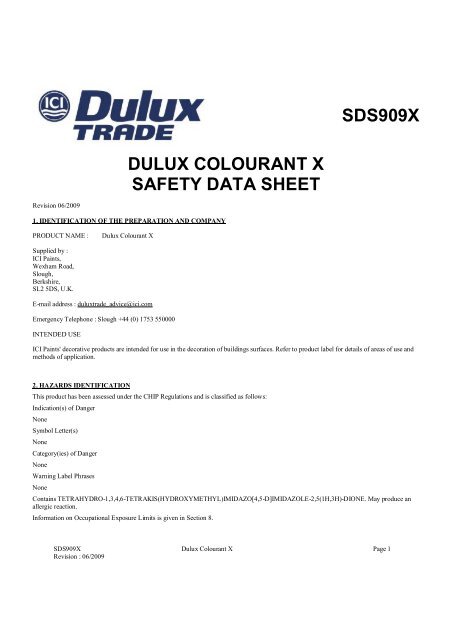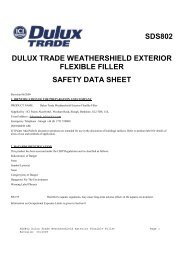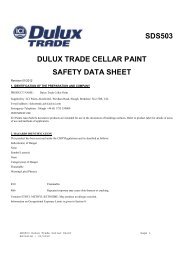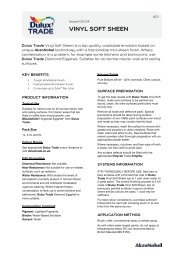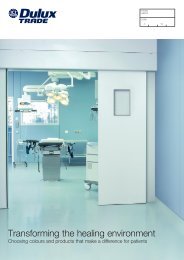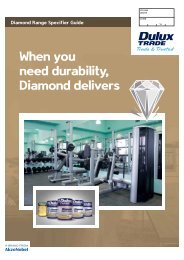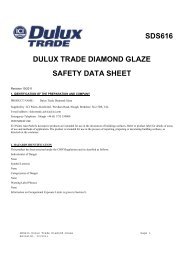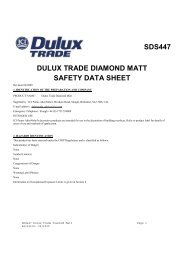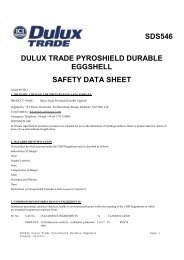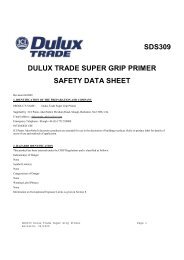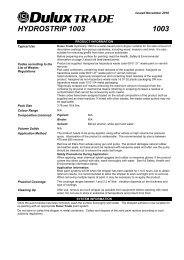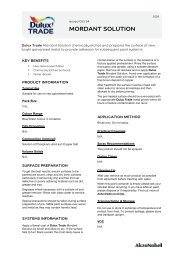SDS909X Dulux Colourant X 5 - Dulux Trade
SDS909X Dulux Colourant X 5 - Dulux Trade
SDS909X Dulux Colourant X 5 - Dulux Trade
You also want an ePaper? Increase the reach of your titles
YUMPU automatically turns print PDFs into web optimized ePapers that Google loves.
<strong>SDS909X</strong>DULUX COLOURANT XSAFETY DATA SHEETRevision 06/20091. IDENTIFICATION OF THE PREPARATION AND COMPANYPRODUCT NAME :<strong>Dulux</strong> <strong>Colourant</strong> XSupplied by :ICI Paints,Wexham Road,Slough,Berkshire,SL2 5DS, U.K.E-mail address : duluxtrade_advice@ici.comEmergency Telephone : Slough +44 (0) 1753 550000INTENDED USEICI Paints' decorative products are intended for use in the decoration of buildings surfaces. Refer to product label for details of areas of use andmethods of application.2. HAZARDS IDENTIFICATIONThis product has been assessed under the CHIP Regulations and is classified as follows:Indication(s) of DangerNoneSymbol Letter(s)NoneCategory(ies) of DangerNoneWarning Label PhrasesNoneContains TETRAHYDRO-1,3,4,6-TETRAKIS(HYDROXYMETHYL)IMIDAZO[4,5-D]IMIDAZOLE-2,5(1H,3H)-DIONE. May produce anallergic reaction.Information on Occupational Exposure Limits is given in Section 8.<strong>SDS909X</strong> <strong>Dulux</strong> <strong>Colourant</strong> X Page 1Revision : 06/2009
3. COMPOSITION/INFORMATION ON INGREDIENTSSubstances presenting a physico-chemical, health or environmental hazard within the meaning of the CHIP Regulations or whichare assigned occupational exposure limits.EC No. CAS No. HAZARDOUS INGREDIENTS % CLASSIFICATION164383-18-0 ETHOXYLATED, PHOSPHATED TERTIARYALCOHOL500-350-9 157707-44-3 AMIDES, C12-18 AND C18-UNSATD., N-(HYDROXYETHYL), ETHOXYLATED1.0-2.5 N, Xi R36/38-51/531.0-2.5 Xi R36226-408-0 5395-50-6 TETRAHYDRO-1,3,4,6-< 1.0 Xi R43TETRAKIS(HYDROXYMETHYL)IMIDAZO[4,5-D]IMIDAZOLE-2,5(1H,3H)-DIONE259-627-5 55406-53-6 IODO PROPYNYL BUTYL CARBAMATE < 1.0 N, Xn R20/22-38-41-50Note: The text for R phrase codes shown above (if any) is given in section 16.Note: 'EC Number' if quoted is the EINECS or ELINCS number.4. FIRST-AID MEASURESIn all cases of doubt, or where symptoms persist, seek medical attention. Never give anything by mouth to an unconscious person.INHALATION: Remove to fresh air, keep patient warm and at rest. If breathing is irregular or stopped administer artificial respiration. Givenothing by mouth. If unconscious place in the recovery position. Seek medical advice.EYE CONTACT: Remove contact lenses. Irrigate copiously with clean, fresh water for at least 10 minutes, holding lids apart. Seek medicaladvice.SKIN CONTACT: Remove contaminated clothing, wash skin thoroughly with soap and water, or use a proprietary skin cleanser. Do not usesolvents or thinners. Seek medical advice if symptoms persist.INGESTION: If accidentally swallowed, DO NOT INDUCE VOMITING. Keep at rest and obtain medical attention.5. FIRE-FIGHTING MEASURESExtinguishing media: Recommended - alcohol resistant foam, CO2, powders.Not to be used - waterjet.Recommendations : Fire will produce dense black smoke. Exposure to decomposition products may cause a health hazard.Fire fighters should wear self-contained breathing apparatus.Closed containers exposed to fire should be cooled with water. Do not allow run-off from fire-fighting to enter drains or water-courses.<strong>SDS909X</strong> <strong>Dulux</strong> <strong>Colourant</strong> X Page 2Revision : 06/2009
6. ACCIDENTAL RELEASE MEASURESExclude non-essential personnel.Exclude sources of ignition and ventilate the area. Avoid breathing vapours. Refer to protective measures listed in section 8. Contain and collectspillage with non-combustible absorbent materials, eg sand, earth, vermiculite or diatomaceous earth, and place in container for disposalaccording to local regulations (see section 13). Do not allow to enter drains or watercourses. Clean spillages thoroughly and quickly with water;do not use solvents or reactive chemicals such as bleach. If the product enters drains or sewers, immediately contact the local water company; inthe case of contamination of streams, rivers or lakes, the relevant environment agency.7. HANDLING AND STORAGEPersons with a history of skin sensitisation problems which are related to substances listed in section 3 of this safety data sheet should only beemployed in processes in which this product is used under appropriate medical supervision.HANDLING CONDITIONS: Prevent air-borne concentrations higher than the occupational exposure limits. Keep the container tightly closed.Exclude sources of heat, sparks and open flame. Avoid skin and eye contact. Avoid inhalation of vapour. Smoking, eating and drinking should beprohibited in storage and use areas. For personal protection, see Section 8. Always keep in containers made of the same material as the supplycontainer, or in containers that are compatible with the product.STORAGE CONDITIONS: Observe the label precautions. Store in a cool, dry, well ventilated place away from sources of heat, ignition anddirect sunlight. No smoking. Prevent unauthorised access. Containers which are opened should be properly resealed and kept upright to preventleakage. Do not use or store any paint container by hanging on a hook.The Manual Handling Operations Regulations 1993 may apply to the handling of certain Paint Products. Products packed in containers of 5 litresand above will be marked with a guide weight; refer to these weights when carrying out an assessment.The principles contained in the HSE guidance note Storage of Packaged Dangerous Substances, should be observed when storing this product.Store separately from oxidising agents, strongly alkaline and strongly acidic materials, amines, alcohols and water.SPECIFIC USE(s): Where applicable refer to the product label and literature for the application and use instructions.8. EXPOSURE CONTROLS/PERSONAL PROTECTIONEXPOSURE LIMIT VALUESHAZARDOUS INGREDIENTLTEL (8hrTWA) ppmLTEL (8hrTWA) mg/m3STEL (15mins) ppmSTEL (15mins) mg/m3NotesNO SUBSTANCES REQUIRED TO BE LISTED IN THIS SECTIONOEL - Occupational Exposure LimitsWEL - Workplace Exposure LimitSUP - Manufacturer's recommended LimitLTEL - Long-term Exposure Limit.TWA - Time weighted AverageSTEL - Short term Exposure Limit (15mins)sk - Risk of absorption through unbroken skinsen - Respiratory sensitiserrd - Figure quoted is for Respirable dustid - Figure quoted is for Inhalable dustFurther guidance on WELs and OELs, and on occupational exposure to harmful materials (including mixed exposures) is givenin HSE Guidance Note EH40.EXPOSURE CONTROLSBefore commencing work, ensure that a COSHH Assessment has been carried out. All personal protective equipment, including<strong>SDS909X</strong> <strong>Dulux</strong> <strong>Colourant</strong> X Page 3Revision : 06/2009
espiratory protective equipment, used to control exposure to hazardous substances must be selected to meet the requirements oflocal regulations.RESPIRATORY PROTECTION: Avoid the inhalation of vapour, particulates and spray mist. Where reasonably practicable, thisshould be achieved by the use of local exhaust ventilation and good general ventilation. If this is not sufficient to maintainconcentrations of particulates and solvent vapour below the occupational exposure limit, respiratory protection must be worn.The selection of respiratory equipment should be in accordance with BS 4275. Recommendations for the selection, use andmaintenance of Respiratory Equipment, and the current certificates of approval are issued annually by the Health and SafetyExecutive.HAND PROTECTION: Wear suitable gloves for protection against materials in section 3.When skin exposure may occur, advice should be sought from glove suppliers on appropriate types and usage times for thisproduct. The instructions and information provided by the glove supplier on use, storage, maintenance and replacement must befollowed.EYE PROTECTION: Eye protection designed to protect against liquid splashes should be worn.SKIN PROTECTION: Cotton or cotton/synthetic overalls or coveralls are normally suitable. Grossly contaminated clothingshould be removed and the skin washed with soap and water or a proprietary skin cleaner.FLATTING: Protective gloves should be worn to avoid the risk of skin irritation. When surfaces are to be prepared for painting,account should be taken of the age of the property and the possibility that lead pigmented paint might be present. There is apossibility that ingestion or inhalation of scrapings or dust arising from the preparation work could cause health effects As aworking rule you should assume that this will be the case if the age of the property is pre 1960.Where possible wet flatting or chemical stripping methods should be used with surfaces of this type to avoid the creation of dust.When dry flatting cannot be avoided, and effective local exhaust ventilation is not available, it is recommended that a dustrespirator is worn, that is approved for use with lead dusts, and its type selected on the basis of the occupational hygiene(COSHH) assessment, taking into account the occupational hygiene exposure standard for lead in air. Furthermore, steps shouldbe taken to ensure containment of the dusts created, and that all practicable measures are taken to clean up thoroughly all depositsof dusts in and around the affected area.The Control of Lead at Work approved code of practice 1998 (ISBN 0 71 7615065) should be consulted for advice on protectiveclothing and personal hygiene precautions.Care should also be taken to exclude visitors, members of the household and especially children from the affected area, duringthe actual work and the subsequent clean up operations.All scrapings, dust, etc. should be disposed of by the professional painting contractor as Special (Hazardous) Waste, with therelevant documentation under The Special Waste Regulations 1996 plus amendment 2001, The Environmental Protection (Dutyof Care) Regulations 1991, The Controlled Waste Registration of Carriers and Seizure of Vehicles Regulations 1991 plusamendment 1998 and the Controlled Waste Regulations 1992 plus amendment 1993.Dry sanding, flame cutting and/or welding of the dry paint film may give rise to dust and/or hazardous fumes. Wet sandingshould be used wherever possible. If exposure cannot be avoided by the provision of local exhaust ventilation, suitablerespiratory protective equipment should be used.Extra precautions will need to be taken when burning off old lead based paints (See above - "Flatting" for relevance to work onolder property, ie pre 1960) as fumes containing lead will be produced.It is recommended that a respirator, approved for use with particulate fumes of lead is selected on the basis of the occupationalhygiene (COSHH) assessment, taking into account the occupational hygiene exposure standard for lead in air.Similar precautions to those given above under the Flatting section should be taken with reference to protective clothing, disposalof scrapings and dusts, and exclusion of other personnel and especially children from the building during actual work and thesubsequent clean up operations.ENVIRONMENTAL EXPOSURE CONTROLS: See section 12 for detailed information.<strong>SDS909X</strong> <strong>Dulux</strong> <strong>Colourant</strong> X Page 4Revision : 06/2009
9. PHYSICAL AND CHEMICAL PROPERTIESPhysical State :LiquidFlash Point : NON FLASH °CSpecific Gravity : 1.426Water Miscibility :pH :YesNo InformationViscosity : N/A (ISO 6mm Range)Initial Boiling Point in °C : 10010. STABILITY AND REACTIVITYCONDITIONS TO AVOID: Extremes of temperature.MATERIALS TO AVOID: Keep away from oxidising agents, strongly alkaline and strongly acidic materials in order to avoid exothermicreactions.HAZARDOUS DECOMPOSITION PRODUCTS: When exposed to high temperatures may produce hazardous decomposition products such ascarbon monoxide and dioxide, smoke and oxides of nitrogen.11. TOXICOLOGICAL INFORMATIONThere is no data available on the product itself. The product has been assessed following the conventional method in the CHIP Regulations and isclassified for toxicological hazards accordingly. This takes into account, where known, delayed and immediate effects and also chronic effects ofcomponents from short-term and long-term exposure by oral, inhalation and dermal routes of exposure and eye contact. See Sections 2 and 15 fordetails of the resulting hazard classification.Over-exposures of vapour are irritating to eyes and respiratory system. Excessive concentrations may produce effects on the central nervoussystem including drowsiness. In extreme cases loss of consciousness may result. Long term exposure to vapour concentrations in excess ofquoted OELs may result in adverse health effects. Splashes entering the eye will cause discomfort and possible damage. Prolonged contact withthe skin may have a defatting effect which may lead to skin irritation and in some cases dermatitis.12. ECOLOGICAL INFORMATIONThere is no specific data available on the product itself.The product should not be allowed to enter drains or watercourses or be deposited where it can affect ground or surface waters.The Air Pollution Control requirements of regulations made under the Environmental Protection Act may apply to the use of this product.Products classified as Marine Pollutants are indicated as such under Transport (section 14).Products classified as Dangerous For the Environment are indicated as such in sections 2 and 15.Any substances in the product that are classified as Dangerous for the Environment, present at concentrations above those requiring listing aregiven in section 3.<strong>SDS909X</strong> <strong>Dulux</strong> <strong>Colourant</strong> X Page 5Revision : 06/2009
13. DISPOSAL CONSIDERATIONSWastes, including emptied containers, should be disposed of in accordance with national regulations.CODES ACCORDING TO THE LIST OF WASTES REGULATIONS:Product as supplied: Assigned as non-hazardous waste code 08 01 12 waste paint and varnish other than those mentioned in 08 01 11.Part-used containers, containing dried residues of the supplied product: Assigned as hazardous waste code 08 01 11* waste paint and varnishcontaining organic solvents or other dangerous substancesUsed containers, rigorously scraped out and containing dried residues of the supplied product: Assigned as non-hazardous waste code 15 01 02plastic packaging OR non-hazardous waste code 15 01 04 metal packaging."Rigorously scraped out" means removing the maximum amount of product from the container by physical or mechanical means (draining orscraping) to leave a residue or contamination that cannot be removed by such means.These codes have been assigned based on the actual composition of the product both as supplied and as dried residues. If mixed with otherwastes, the waste codes quoted may not be applicable.14. TRANSPORT INFORMATIONTransport within user's premises:Always transport in closed containers that are upright and secure. Ensure that persons transporting the product know what to doin the event of an accident or spillage.Transport to be in accordance with ADR for road, IMDG for sea. The transport classifications provided in this section are notvalid for transport by Air. Please call the number in section 1 of this safety data sheet to obtain more information on this productsclassification for Air transport.ADR Classification InformationIMDG Classification InformationUN Number : 0000 UN Number : 0000Proper Shipping Name :UN NUMBER NOTREQUIREDProper Shipping Name :UN NUMBER NOTREQUIREDHazard Class : EX Hazard Class : EXSub-Hazard Class : Sub-Hazard Class :Packing Group : EX Packing Group : EXTechnical Name (NOS only) : Technical Name (NOS only) :Ltd Qty Code : Ltd Qty Maximum :Packing Instructions : Packing Instructions :Marine Pollutant if indicatedhere:Emergency Schedule No :Flashpoint :NON FLASH<strong>SDS909X</strong> <strong>Dulux</strong> <strong>Colourant</strong> X Page 6Revision : 06/2009
15. REGULATORY INFORMATIONThis product has been assessed under the CHIP Regulations and is classified as follows:NAMED SUBSTANCESContainsNo substances are required to be named in this sectionINDICATION(S) OF DANGERNoneSYMBOLS LETTER(S)NoneWARNING LABEL PHRASES:J38WATER-BASED COLOURANTP99Contains tetrahydro-1,3,4,6-tetrakis(hydroxymethyl)imidazo[4,5-d]imidazole-2,5(1h,3h)-dione. Mayproduce an allergic reaction.S24/25 Avoid contact with skin and eyes.J33When using it is advisable to wear eye protection.S26In case of contact with eyes, rinse immediately with plenty of water and seek medical advice.J34After contact with skin, wash immediately with plenty of soap and water or a proprietary skin cleanser.Do not use solvent, thinners or white spirit.S2Keep out of the reach of children.S7Keep container tightly closed.J82Do not empty into drains or watercourses.J17Safety data sheets available for professional user on request.J110This includes waste hazard categories.J40In case of spillage clean up thoroughly and quickly with water.J45For further advice contact: ICI Paints Technical Group, Wexham Road, Slough SL2 5DS.Tel: 0870 242 1100. See www.duluxtrade.co.ukWhere 'J'and/or 'P' phrases are denoted, these are ICI Paints or paint industry reference codes to additional phrases.Out of Scope of VOC Regulations16. OTHER INFORMATIONText for R Phrases shown in section 3 describing each ingredient:R20/22 Harmful by inhalation and if swallowed.R36Irritating to eyes.R36/38 Irritating to eyes and skin.R38R41R43R50Irritating to skin.Risk of serious damage to eyes.May cause sensitisation by skin contact.Very toxic to aquatic organisms.<strong>SDS909X</strong> <strong>Dulux</strong> <strong>Colourant</strong> X Page 7Revision : 06/2009
R51/53 Toxic to aquatic organisms, may cause long-term adverse effects in the aquatic environment.The information in this safety data sheet is required in pursuant to the CHIP Regulations.You should satisfy yourself that your COSHH Assessment is in accordance with the COSHH Regulations and Approved Code ofPractice. ICI does not accept any responsibility for your COSHH Assessment. Other Reference: The Control of SubstancesHazardous to Health Regulations (COSHH).The information on this sheet is not a specification: it does not guarantee specific properties. The information is intended toprovide general guidance as to health and safety based upon our knowledge of the handling, storage and use of the product. It isnot applicable to unusual or non-standard uses of the product nor where instructions and recommendations are not followed.We will be pleased to answer any specific enquiries regarding the safe use, storage and handling of our product.Contact: ICI PAINTS Technical Group, Wexham Road, Slough, Berks. SL2 5DSTelephone: 0870 242 1100ICI Paints in the UK is part of Imperial Chemical Industries PLC and a member of the ICI Paints World Group. Registered inEngland No. 218019.Registered office: 20 Manchester Square, London, W1U 3AN.REVISION 06/2009 CHANGES TO SECTION 1 COMPARED WITH PREVIOUS VERSION DATED 04/2008 WHICH ISNOW SUPERSEDED.<strong>SDS909X</strong> <strong>Dulux</strong> <strong>Colourant</strong> X Page 8Revision : 06/2009


